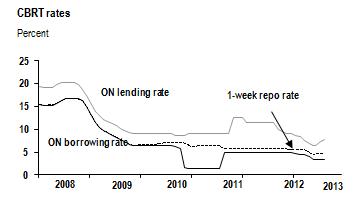|
- The CBRT raised
the upper band of the interest rate corridor by 50bp but only for
non-primary-dealers.
- The
frequency of the extraordinary days will determine the extent of
the monetary tightening
- The
cautious language used in the interest rate note leaves the door
open to further hikes.
The CBRT managed to
surprise the markets yet again and introduced extra creativity and
complexity to its unorthodox monetary policy scheme further by
creating a new interest rate corridor within the already existing
corridor. According to survey results, market players were divided
between those expecting no change and those expecting a 50bp hike
in the upper band (the CBRT’s ON lending rate) of the corridor. The
decision came out to be something in-between. The CBRT kept the
upper band for primary dealer banks unchanged at 6.75% and hiked
the upper band for non-primary dealer banks by 50bp to 7.75%. The
other parameters of the scheme (ie the lower band of 3.5%, the
policy rate of 4.5% and the ROCs and RRRs) were left unchanged as
expected.
Before starting to
analyze the decision, we should note that primary dealers are
allowed to borrow at a discount from the CBRT only on normal days
while on extraordinary days all market players borrow at the more
expensive non-PD rate (which is now 7.75%). The decision suggests
that on normal days when the CBRT opens its traditional 1-week repo
auctions, the upper band of the interest rate corridor will still
be 6.75%. However, on extraordinary days when the CBRT refrains
from funding the market through 1-week repo auctions, the upper
band of the corridor is raised to 7.75% from a pervious 7.25%. This
means that inside the normal interest rate corridor of 3.50-7.75%
there is now another (and widening) interest rate corridor this
time only for the upper band that extends between 6.75% and
7.75%.

This new scheme will 1)
allow the CBRT to increase its effective funding rate swiftly
towards 7.75% on extraordinary days when the lira gets under
pressure and 2) create extra volatility in funding rates that could
discourage the banks from extending new loans and thus helping the
CBRT in demand management and thus in bringing inflation
down.
Not surprisingly,
market participants are having difficulty in evaluating the CBRT
decision. This is surely a type of monetary tightening but its
impact will most probably not be as large as a regular rate hike or
even a regular upper band hike. The extent of the monetary
tightening will depend on the frequency of the extraordinary days.
Note that the CBRT had only three extraordinary days in the last
thirty days. Unless the frequency increases, today’s decision will
not produce any result.
The main risk with
increased complexity is that of a further loss of interest by the
international investors. Given Turkey’s continued need for
portfolio inflows, this could create further market volatility. On
the other hand, more frequent extraordinary days and thus higher
funding rates along with the expected downward trend in inflation
would help to recover investor appetite and thus support Turkish
financial asset prices.
Looking at the one-page
announcement note, we see that as expected the CBRT maintains its
cautious tone. Importantly, the note states that “in order to
contain the adverse impact of the above-target inflation indicators
on the pricing behavior, the Committee has decided to strengthen
the cautious stance of the monetary policy” and that “the cautious
stance will be maintained until the inflation outlook is in line
with the medium term targets’. “ In this respect, additional
monetary tightening will be implemented whenever needed.’ This
cautious rhetoric shows that the CBRT leaves the door open for
further rate hikes if needed.
Elsewhere, the CBRT has
slightly downgraded its domestic demand outlook. After saying that
“domestic demand follows a healthy recovery”, the Bank now sees
“domestic demand growing at a moderate pace”. Finally, the CBRT
sounds more upbeat on the external balances. The CBRT emphasizes
the continuing improvement in the current account deficit and
states that “the current policy framework, with the additional
support from recent macroprudential policies, will continue to
improve the current account balance.”
|